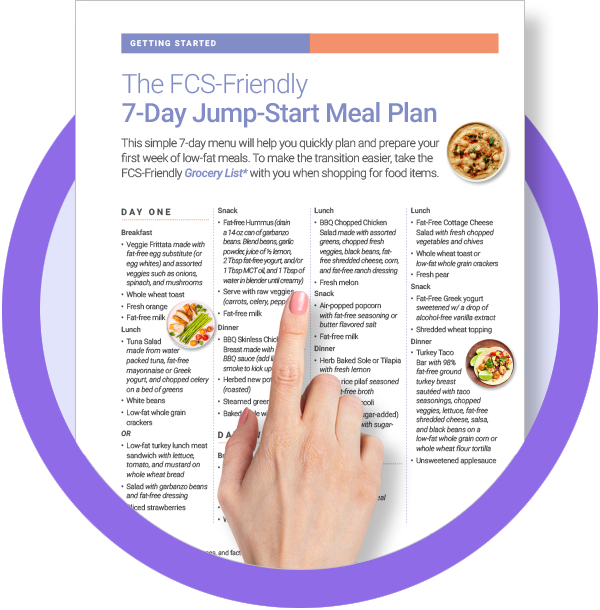What are some nutrition and lifestyle strategies?
Use the 3Ps to help navigate the challenges of living with familial chylomicronemia syndrome.
Whether you or a family member has FCS, it is helpful to know the 3 Ps – preparation, practice, and positivity.
Preparation: Plan for Your Success.
Take control of what you eat, while also saving time with shopping and cooking.
- Work with a dietitian to plan an FCS-friendly diet. Here are some FCS-friendly foods you can enjoy:
- leafy greens and colorful vegetables
- beans, peas, and lentils
- non-oily white fish, like cod, skate, haddock, or canned tuna in water
- breast of most poultry (white meat), skinned and trimmed of all fat
- most shellfish, including shrimp, squid, and lobster
- egg whites
- fat-free milk, fat-free cheese, and fat-free plain yogurt
- complex carbohydrates, like whole grain bread and whole grain pasta
- herbs and spices – most are non-fat!
- water, tea, and coffee
- MCT oil can help you cook – read more below
- Become an expert at reading Nutrition Facts food labels so you know what’s inside the package.
- Keep a list of favorite foods. Having FCS doesn’t mean having to say goodbye to certain foods altogether. You can still make foods you love by substituting lean proteins, removing cooking oils and fats, and including fat-free versions of ingredients (like fat-free cheese or yogurt).
- Cook meals for the week ahead of time on weekends or days off.
- Have healthy snacks on hand for emergencies. Having frozen vegetables that can be quickly steamed in the microwave or prepared snacks like cut up bell peppers or egg whites can be helpful.
- Make a menu for the week ahead and have the right ingredients on hand when it’s time to cook. Having a routine can help.
- Read dining-out menus online so you don’t feel pressured to choose while at the restaurant. Consider a low-fat snack before you go so your hunger is contained. It’s also nice to have regular restaurants where the staff knows you and how you like to eat!
Click the fact sheets below to download the FCS-Friendly 7-Day Jump-Start Meal Plan and the companion Grocery List. Use these fact sheets when starting a low-fat diet or if you need to just get back on your game!


Practice: Adopt Healthy Habits for a Lifetime.
Repetition builds routine, so eventually an FCS-friendly lifestyle will become second nature.
- Let others know about FCS and how they can help. To avoid uncomfortable conversations, some people with FCS simply explain that they’re “allergic to fat.” While it is not quite accurate, it may help others quickly grasp that FCS is a serious condition, and that even a tiny bit of fat can make you sick.
- When it comes to health, it pays to speak up. Ask for sauces on the side. Remind the chef not to use any oil or butter in cooking. Bring fat-free dressing along for salads.
- Eat smaller, more frequent meals. Avoid hunger by eating every 2-3 hours.
- Monitor your body’s response. Many FCS-friendly foods are high in fiber. If you are not accustomed to eating this way, increase your intake of veggies, fruits, whole grains and beans gradually, as tolerated.
- Keep a water bottle handy. Sometimes our bodies interpret dehydration as hunger, so drink lots of water. Staying hydrated may also reduce the risk of pancreatitis and help with high-fiber diets.
Positivity: Use Optimism to Your Advantage.
Instead of dwelling on what you can’t eat or can’t do, discover and embrace “the can” in life.
- Spend time cooking with your family or friends. The National Lipid Association has many resources including FCS friendly recipes you can try to make together.
- Enjoy every mouthful. Take a bite. Chew slowly. Eating mindfully can create a more satisfying and filling mealtime experience.
- Experiment with new flavors and spices. Have fun! You may be surprised & find something you enjoy.


